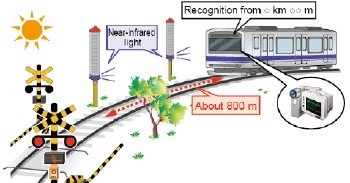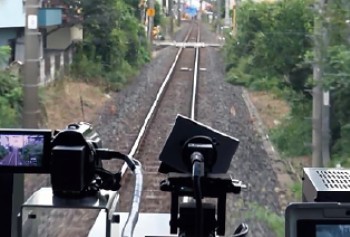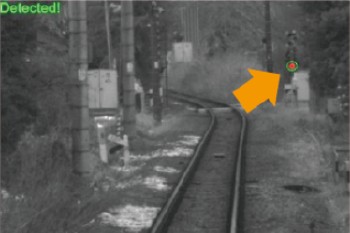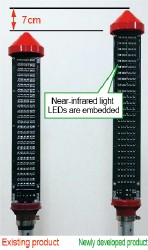18.System for inspecting obstruction warning signals
Obstruction warning signals do not emit light during normal service hours and therefore it is necessary to turn them on to check their visibility during inspection. In order not to affect railway operations, these inspections therefore have to be conducted after normal operating hours. This work is time and labour consuming and therefore a costly problem.
As a solution, an inspection system has been developed using near-infrared light invisible to the naked eye and a camera capable of picking up this near-infrared light, which allows verification of the light emitted from the obstruction warning signal from onboard a running train (Fig. 1).
The new system can be used to carry out inspections during daytime operating hours, making the procedure efficient and cost effective. The prototype of this system, (Fig. 2: onboard measurement device; Figs. 3 and 4: Obstruction warning signal) were monitored over an extended period of time, confirming that the device can function unimpeded by the weather, season or time of operation.
Image data for the whole line can be obtained in just one return journey, reducing the overall inspection time in terms of days, to nearly 30% of the time required with the existing method, according to calculations on a model line. In addition, the new inspection method is more accurate, since the obtained image is continuous and therfore visibility can be inspected right up until the train has passed the signal.
In order to implement the new method, it will be necessary to replace existing obstruction warning signals with the newly developed signals and equip trains with the portable onboard inspection device.
Other Contents
- 13.Sheet pile reinforcement work on pile foundations during ground liquefaction
- 14.Countermeasure for fatigue cracks around I-beam bridge supports
- 15.Countermeasure work on ballasted Shinkansen track to prevent ballast migration
- 16.Method for detecting damage and repairing slab track cement asphalt mortar layers
- 17.Decision-making support system for planning replacement of wooden-sleepers with PC sleepers in curved sections
- 18.System for inspecting obstruction warning signals
- 19.Possibility of practical application of a 920MHz bandwidth network
- 13.Sheet pile reinforcement work on pile foundations during ground liquefaction
- 14.Countermeasure for fatigue cracks around I-beam bridge supports
- 15.Countermeasure work on ballasted Shinkansen track to prevent ballast migration
- 16.Method for detecting damage and repairing slab track cement asphalt mortar layers
- 17.Decision-making support system for planning replacement of wooden-sleepers with PC sleepers in curved sections
- 18.System for inspecting obstruction warning signals
- 19.Possibility of practical application of a 920MHz bandwidth network




